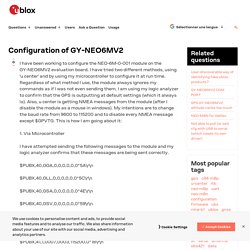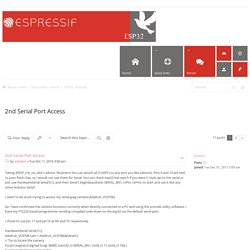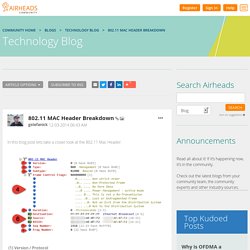

Ublox NEO-6M-0-001 gps reciver commands - u-blox forum. Configure Neo-7 to use baud rate of 57600/9600 via terminal on Linux - u-blox forum. Configuration of GY-NEO6MV2 - u-blox forum. I have been working to configure the NEO-6M-0-001 module on the GY-NEO6MV2 evaluation board.

I have tried two different methods, using 'u center' and by using my microcontroller to configure it at run time. Regardless of what method I use, the module always ignores my commands as if I was not even sending them. I am using my logic analyzer to confirm that the GPS is outputting at default settings (which it always is).
Also, u center is getting NMEA messages from the module (after I disable the module as a mouse in windows). My intentions are to change the baud rate from 9600 to 115200 and to disable every NMEA message except $GPVTG. 1. I have attempted sending the following messages to the module and my logic analyzer confirms that these messages are being sent correctly. $PUBX,40,GGA,0,0,0,0,0,0*5A\r\n $PUBX,40,GLL,0,0,0,0,0,0*5C\r\n $PUBX,40,GSA,0,0,0,0,0,0*4E\r\n. 2nd Serial Port Access - ESP32 Forum. Taking @ESP_me_no_dev's advice "@a2retro You can attach all 3 UARTs to any pins you like (almost).

Pins 9 and 10 are tied to your flash chip, so I would not use them for Serial. You can check esp32-hal-uart.h if you want C style api to the serial or just use HardwareSerial Serial1(1); and then Serial1.begin(baudrate, SERIAL_8N1, rxPin, txPin); to start and use it like any other Arduino Serial" I seem to be stuck trying to access my serial jpeg camera (Adafruit_VC0706) So I have confirmed the camera functions correctly when directly connected to a PC and using the provide utility software. I have my FT2232 based programmer sending compiled code down to the esp32 via the default serial port. Hardware serial 2 does not work · Issue #665 · espressif/arduino-esp32. G6EJD/ESP32-Using-Hardware-Serial-Ports: How to use ESP32 hardware serial ports. Plieningerweb/esp8266-software-uart: Software UART / Software Serial / SoftUart for ESP8266 to connect more than one UART. SoftwareSerial is unstable in 2.4.0 · Issue #63 · plerup/espsoftwareserial.
802.11 MAC Header Breakdown. In this blog post lets take a closer look at the 802.11 Mac Header. (1) Version / Protocol The version field in the mac header identifies what wireless version of the protocol is being used. “0” identifies 802.11, WiFi as we know it today.

The version / protocol field is 2 bits in length. 802.11 Mgmt : Beacon Frame. Beacon frames are used by the access points (and stations in an IBSS) to communicate throughout the serviced area the characteristics of the connection offered to the cell members.
This information used by clients trying to connect to the network as well as clients already associated to the BSS. Beacons are sent periodically at a time called Target Beacon Transmission Time (TBTT) 1 TU = 1024 microseconds Beacon interval =100 TU (100x 1024 microseconds or 102.4 milliseconds) Here is the frame format of a Beacon frame. Home & Small Business at Wi-Fi Planet. By Jim Geier (Back to article) In a previous tutorial, I provided an overview of the various frame types that 802.11 stations (network cards and access points) use to support wireless data communications.
In addition to data frames that carry information from higher layers, 802.11 includes management and control frames that support data transfer. The beacon frame, which is a type of management frame, provides the "heartbeat" of a wireless LAN, enabling stations to establish and maintain communications in an orderly fashion. Beacon frame. Components[edit] Beacon frames consist of an 802.11 MAC header, body and FCS[1].
Some of the fields in the body are listed below. Infrastructure network access points send beacons at a defined interval, which is often set to a default 100 TU which is equivalent to 102.4 ms. In the case of an ad hoc network where there are no access points, a peer station is responsible for sending the beacon. After an ad hoc station receives a beacon frame from a peer, it waits a random amount of time. Most access points allow the changing of the beacon interval. Inspecting an idle network with packet-monitoring tools such as tcpdump or Wireshark would show that most traffic on the network consists of beacon frames, with a few non-802-11 packets mixed in, such as DHCP packets. Stations must schedule beacon transmission at the nominal beacon interval. Function[edit] While beacon frames do cause some non-trivial overhead for a network, they are vital for the proper operation of a network. References[edit] WLAN Probe Request frame.
CWAP 802.11- Probe Request/Response. Discovering the network by scanning all possible channels & listening to beacons is not considered to be very efficient (passive scanning).

To enhance this discovery process, stations often use what is called active scanning. In Active scanning, stations still go through each channel in turn, but instead of passively listening to the signals on that frequency, station send a Probe Request management frame asking what network is available on that channel. Probe Request are sent to the broadcast DA address (ff:ff:ff:ff:ff:ff). Once a Probe sent, STA starts a ProbeTimer countdown & wait for answers. At the end of the timer, STA process the answer it has received. STA sending Probe Request may specify the SSID they looking (called directed probe request). Here is a frame capture of a client association to a BSS. Below shows the detail of Probe Request frame sent by the client which is a management type with subtype value of 4.
Here is the Probe Response. 1. References 1. Related Posts. CWAP 802.11- Probe Request/Response. CWAP 802.11- Probe Request/Response. Battery alternative for DS3231 ?